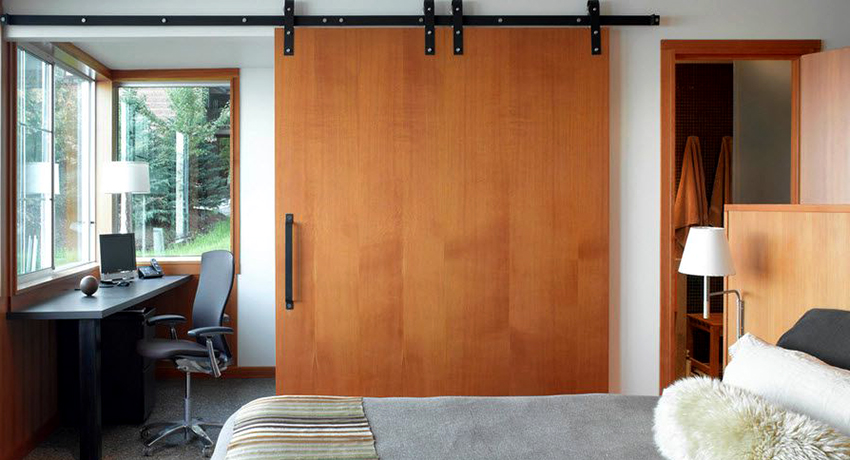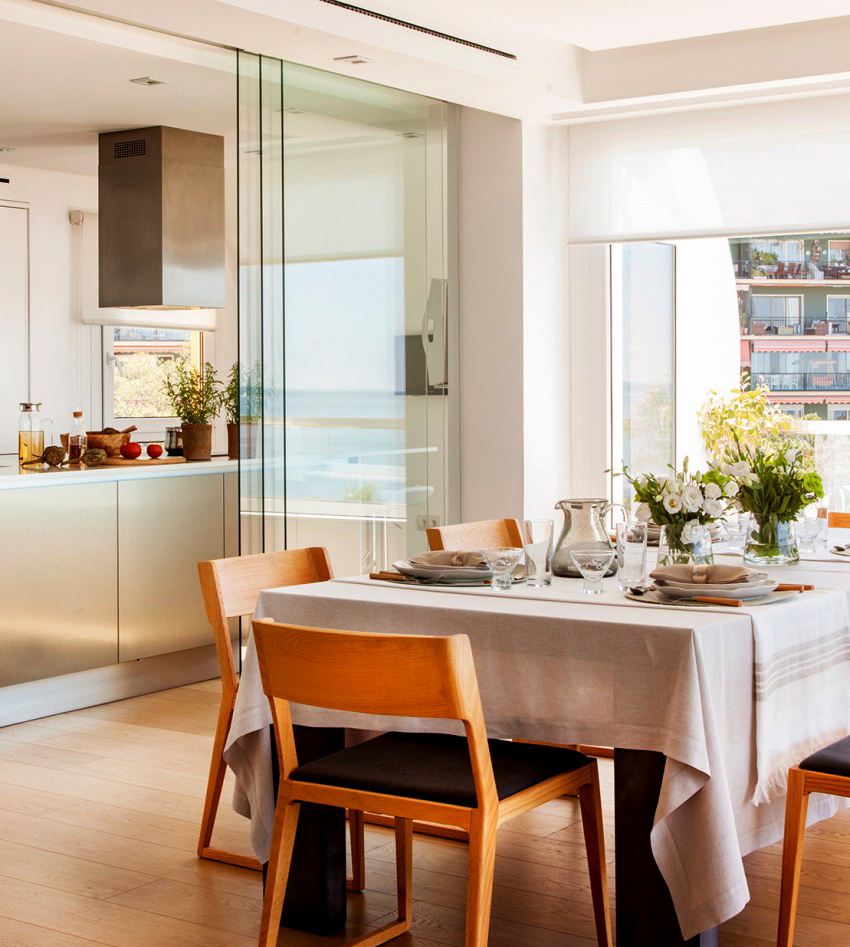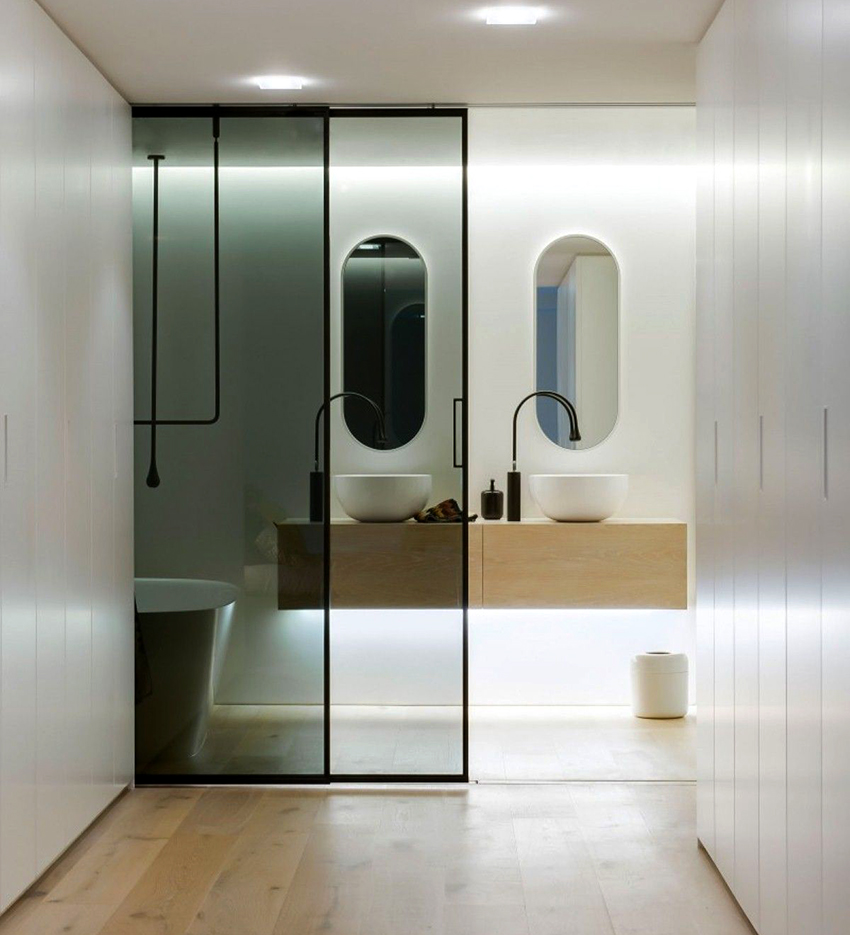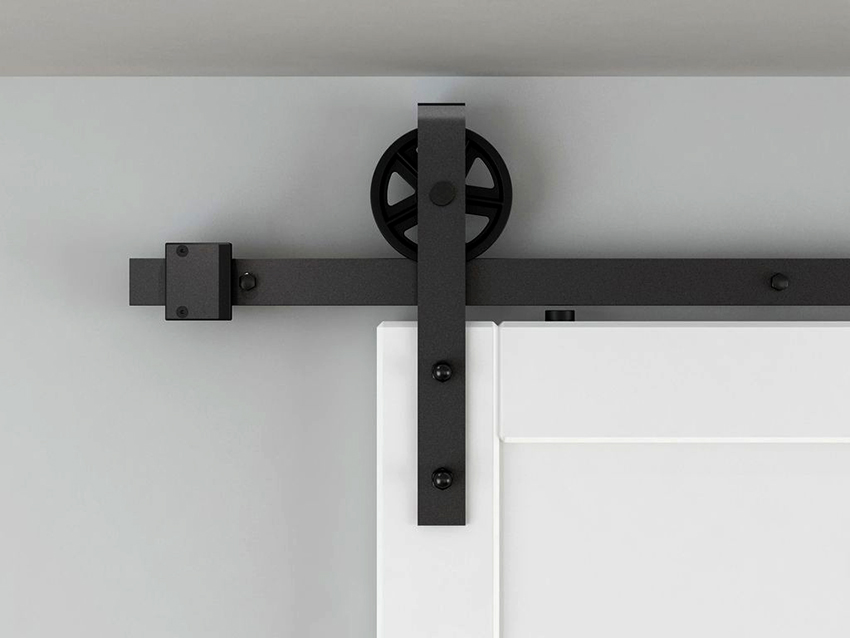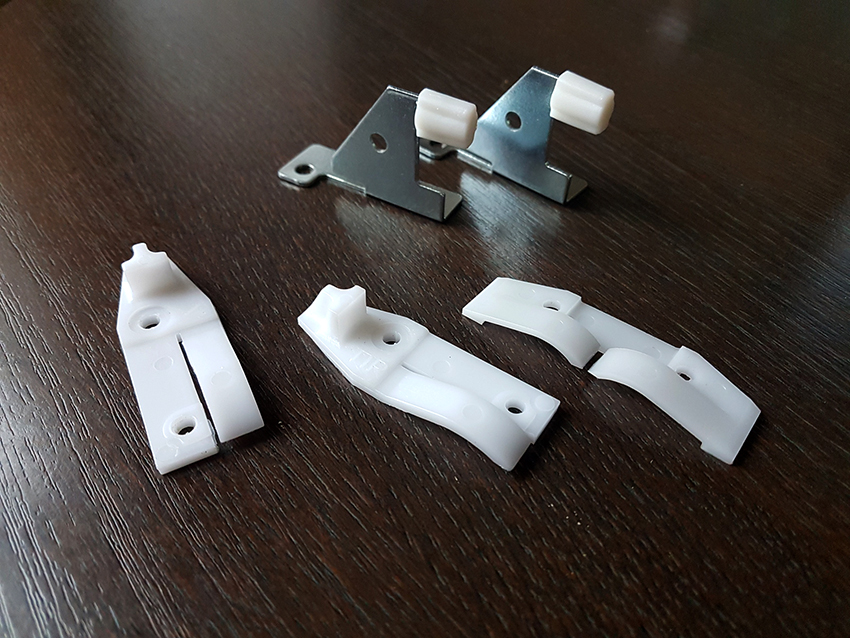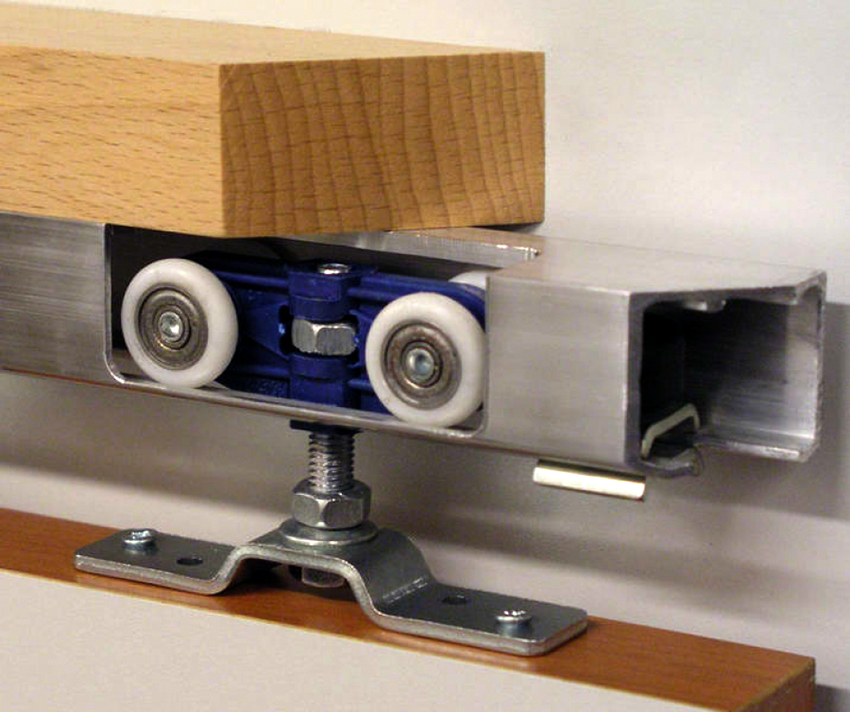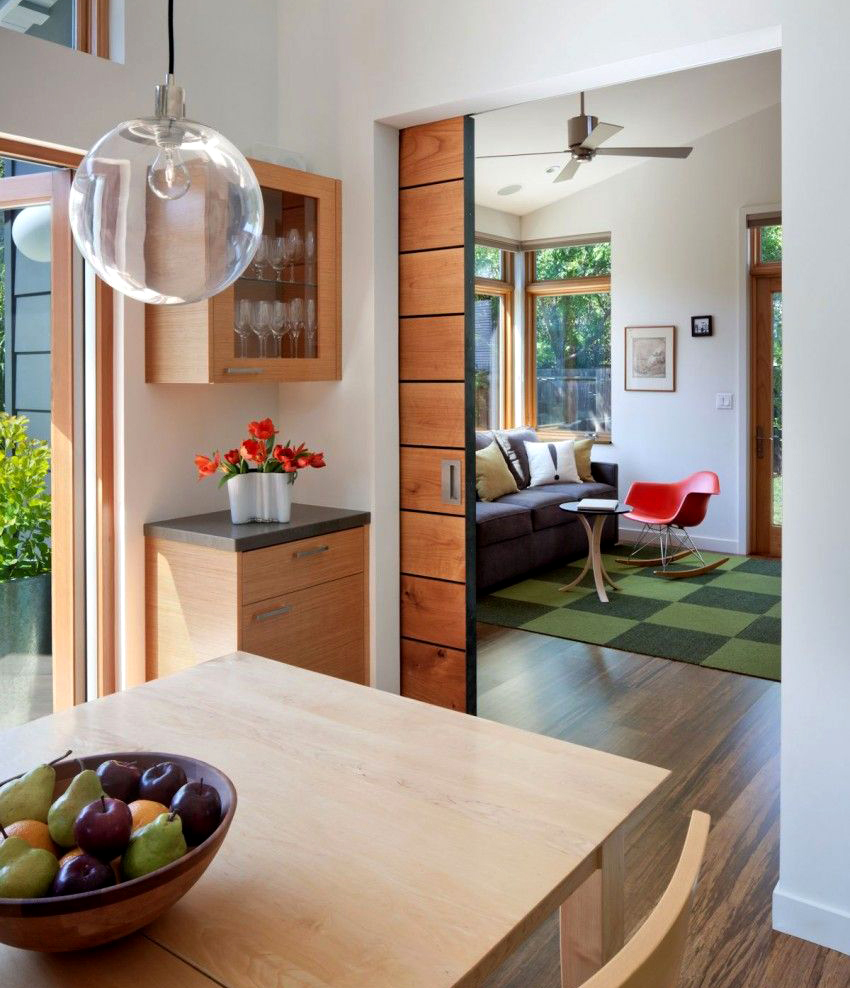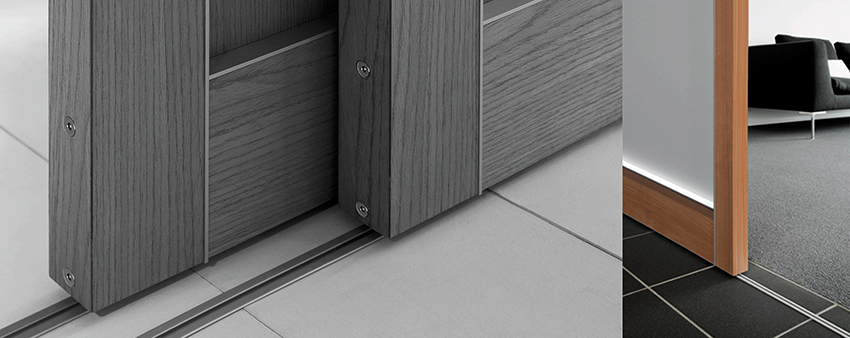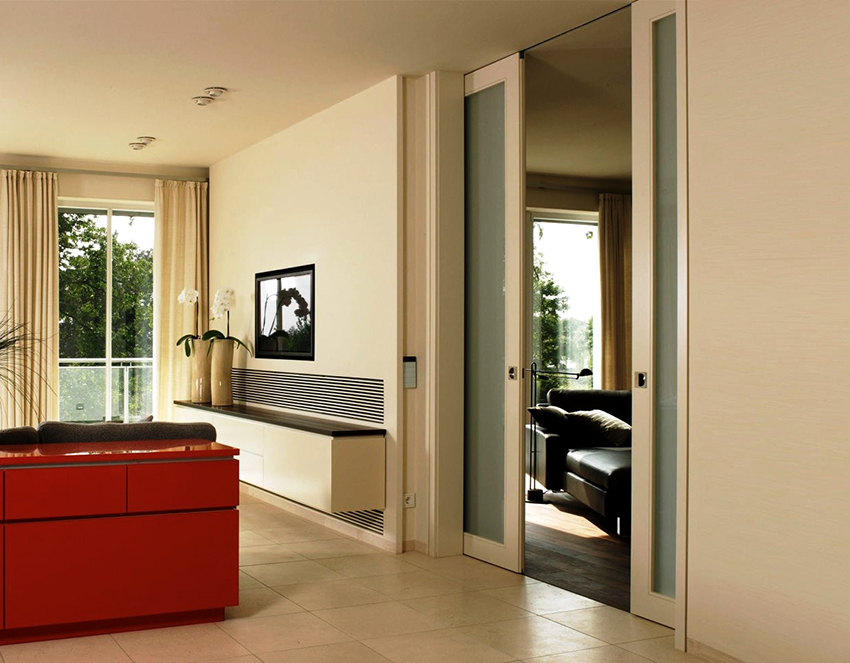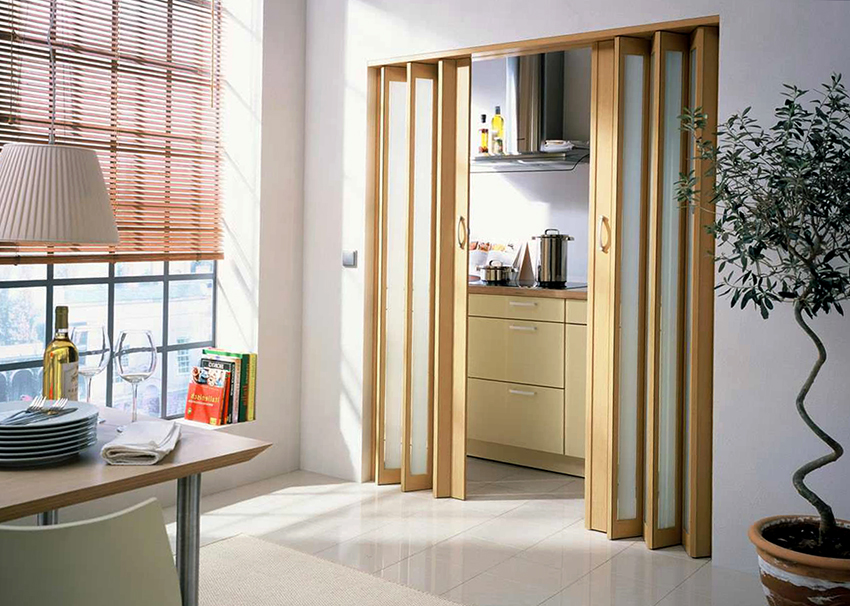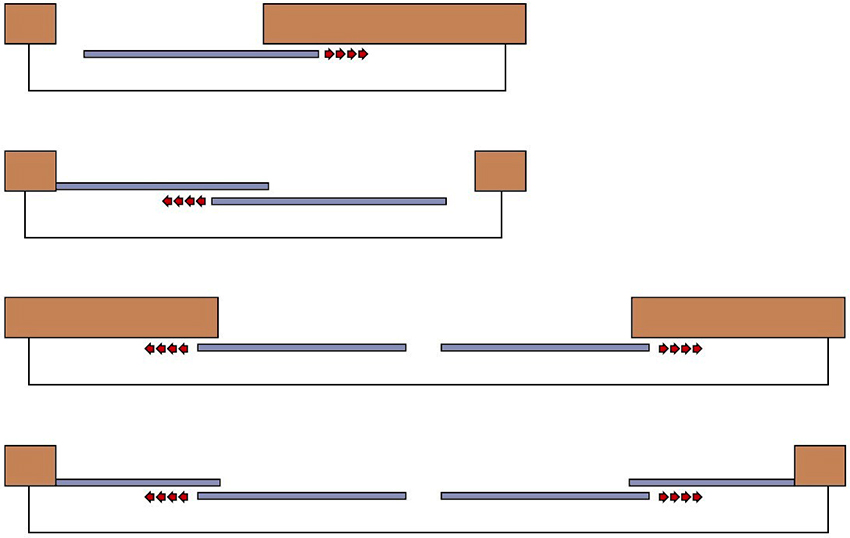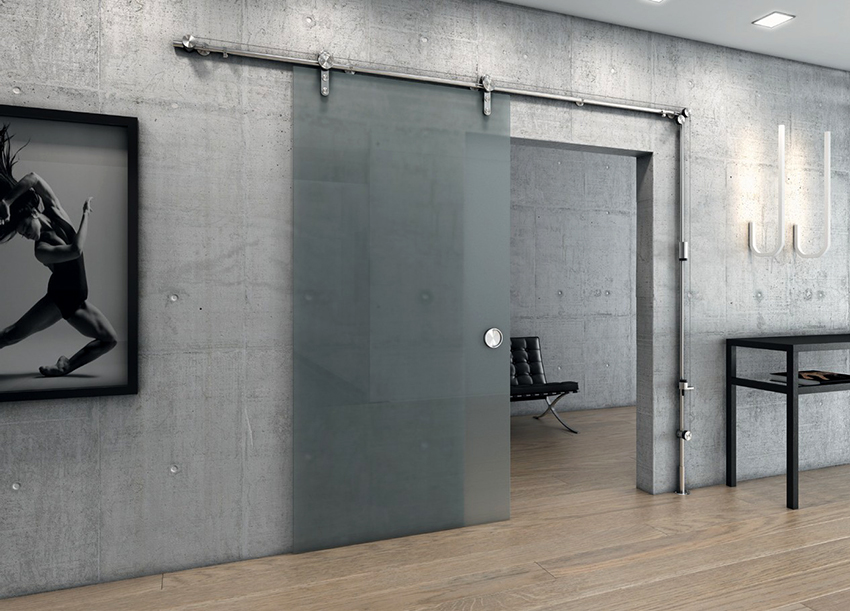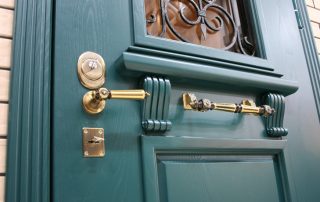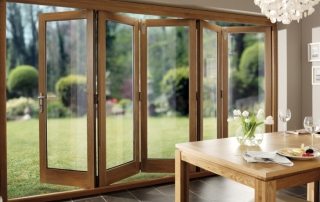Sliding systems are very popular today. Such a door does not take up much space, moves noiselessly, does not slam, and is easy to use. In order for the sliding system to please the owners with its uninterrupted and durable operation, it is necessary to choose a high-quality mechanism for it and install it correctly. What are the design options? What is the best mechanism for a sliding door? All information can be found in this article.
Content [Hide]
- 1 Reasons for the popularity of the sliding door system
- 2 Sliding door mechanism: set components
- 3 Types of sliding door mechanisms by sliding method
- 4 System designs with different numbers of slide rails for sliding doors
- 5 Mechanism options depending on the type of sliding doors
- 6 Varieties of sliding interior door systems
- 7 Features of the sliding mechanism for glass doors
- 8 How to install sliding doors: installation sequence
Reasons for the popularity of the sliding door system
The traditional swing door has been replaced by a sliding system, which is very popular due to a number of its distinctive features. The sliding door allows you to significantly save free space. The doors do not swing open in different directions, but move in the same plane, parallel to the wall. Accordingly, no free space is needed to open the doors. This is especially valuable in small spaces. For a canvas, it is enough to organize a narrow space along the wall. Therefore, no furniture or decorative elements should be installed in this area.
Installation of a sliding door is not a laborious and complicated undertaking, which cannot be said about the installation of a swing door. The doorway remains unchanged. When installing the door, the integrity of the walls is not compromised The sliding system is characterized by reliability and long service life. This is due to the fact that when sliding, the sash experiences a much lower load and does not lend itself to impacts during intensive use, like a swing sash. The service life of the product is extended by at least 15%. However, in order to obtain a durable structure, it is important to choose a quality sliding door mechanism.
Smooth movement of door leaves eliminates the possibility of slapping children's fingers and animal tails. The presence of special latches on the guides for the doors allows you to leave it in the desired position, eliminating slamming at the wrong moment.
The main requirement when installing a sliding system for its normal functioning is that the wall along which the sash will move must be flat. This rule applies to a two-skid system. For a single-track design, in which the rail is attached to the ceiling, this condition is not necessary. The sliding system can be mounted to a wall or ceiling. The second option is advisable to use when organizing a partition using such a door.
Useful advice! A sliding system is a good solution for space zoning.
The main disadvantage of a sliding system is the low degree of sound and heat insulation compared to a swing door. The price of this option is slightly higher than the cost of traditional doors. This is due to the complexity of the rail mechanism.
Sliding door mechanism: set components
Mechanisms for sliding doors are presented in a wide variety of types and differ mainly in the specifics of the movement of the leaves. Therefore, the device includes the same elements, which may differ in design and workmanship.
The set for sliding doors includes a door leaf, which can consist of one or more leaves, upper and / or lower guides, rollers for moving the leaves. Profiles are used as guides, which may differ from each other by the presence of tracks. It depends on how the sash moves: with an overlap or end-to-end. When choosing profiles for sliding doors, you should pay close attention to the material of manufacture. They can be made of steel or aluminum.
Important! Do not choose aluminum guides for massive door leaves, as they can deform over time, which will impair the ease of use of the sliding system.
Roller supports can also be made in different modifications, which is determined by the number of wheels and the variant of the sliding system. Two or four wheels can be located on one support. This is determined by the weight of the door leaf. If it has a mass of up to 80 kg, a mechanism with two supports will be sufficient. For a massive door, you will need at least four. The wheels can also be positioned symmetrically and asymmetrically, with some offset.
The sliding door system can be additionally equipped with locking elements that fulfill an important function. Such limiters of movement, in the case of a close arrangement of the perpendicular surface, prevent a hard blow of the door leaf against the wall, and also prevent the roller from flying out of the profile guide.
Locking elements prevent spontaneous movement of the web. With the help of such stops, it can be fixed in a certain position. To increase the ease of use and improve the aesthetic component, the mechanism for sliding systems may include closers, cables, hooks, mini-electric motors, decorative strips behind which the mobile mechanism can be hidden. The sliding system can be equipped with a threshold or be without it.
Types of sliding door mechanisms by sliding method
The sliding door sliding system can be an open or closed design. The first option has a simple modification. The sliding mechanism includes guides and roller support elements. The number of profiles depends on the design of the door, stability in the opening, the specifics of its operation and other factors. The open design is easy to install.It can be installed in any doorway, regardless of the material of manufacture for the walls, its structure.
Important! The open version is used when arranging a partition using a sliding system.
A type of open system is the barn mechanism for a sliding door, which consists of a guide, rollers, special fasteners for the door and door leaf. This design is used for spacious walkways. The mechanism is made of steel, is characterized by smooth and quiet running, which is facilitated by reliable bearings. The device is complemented by a special closer.
Useful advice! The barn system is the ideal sliding gate mechanism.
System characteristics for closed sliding doors
Closed sliding door systems are installed much less frequently. In this case, the door leaf is partially or completely hidden in the wall. This option can be used in the case of organizing a frame-type interior partition. She remains hollow inside, where the door can freely move, hiding in her body.
When installing a closed-type sliding system near a regular wall surface, the structure is additionally equipped with a cassette, which is mounted to the wall, forming a niche for the door. It is made from the same material as the door leaf. The cassette can be made with your own hands from drywall or other material.
The advantages of a sliding door in the wall include an original appearance and ease of use. It is impossible not to mention the disadvantages of this option, which are low maintainability and difficulty in maintenance. In case of problems with the sash or stopper, it is necessary to dismantle part of the partition, breaking its lining. It will be very problematic to completely replace the roller mechanism, especially if the door leaves overlap with an overlap and their width exceeds half the doorway.
In the niche for the door leaf, dust will gradually accumulate, which is difficult to remove. Subsequently, such a blockage can lead to jammed doors and incorrect operation of the entire system.
System designs with different numbers of slide rails for sliding doors
The sliding system can be represented by a single-track or two-track mechanism. In the first case, the canvas moves along one profile rail, which is fixed at the top to the wall or ceiling. The bottom rail is completely absent. You can buy a guide for a sliding door in the form of a single or double structure. The first option is used for a single-leaf blade that can move in one direction. A double telescopic rail is installed for two leaves that move overlapping each other.
In such a suspension mechanism for sliding doors, there is no fixation of the position of the leaf, therefore, light doors of small thickness should be installed here. At the bottom there are only limiters.
Important! A door that is too light in a suspended structure will swing in a draft, which will reduce its operational functions.
This option is inconvenient in terms of sound and heat insulation of the room. However, there is also a positive aspect here, which implies the possibility of natural circulation of air flow in the room.
As the top guide for sliding doors, not only a profile can be used, but also a pipe or a metal rod, which diversifies the choice of installation method.
Mechanism of two guides for interior sliding doors
The two-track system assumes the presence of two guides: lower and upper. At the same time, the door leaf is moved using a roller mechanism for sliding doors, which is located on the lower rail. It can be single or double, which will provide free movement of two leaves. The rail is mounted to the floor. The bottom rail for the sliding door must be cleaned periodically for the system to function effectively and lastingly.
The top rail is used to keep the sash upright. It must be of the same type and material of manufacture as the lower one. In such a system, the stopper elements are attached to the top of the wall, and the movement stops are installed at the bottom. This floor-standing option is advisable to use for massive, heavy and large doors.
The two-rail system has several significant advantages. It is more reliable, capable of withstanding a significant load, allows you to reliably fix the canvas in the upper and lower planes, which eliminates the possibility of its swinging even in a strong draft. Therefore, it is used as a mechanism for sliding doors of wardrobes.
However, the installation of such a system is more laborious and complex. To ensure the effective operation of the structure, before installing it, it is important to correctly markup for attaching the guides, which should be located strictly one below the other.
There is a combined version, equipped with two guides along which the rollers move. It is advisable to use such a mechanism for sliding doors for very heavy curtains, which will evenly distribute the load from the structure over the entire area. This option also contributes to easy and convenient operation.
Useful advice! The combined version of the sliding system is best suited for families with small children, since the doors begin to move even with a light touch.
Mechanism options depending on the type of sliding doors
The choice of the mechanism option depends on the type of sliding door design, which can be synchronous, telescopic and tramway.
Related article:
What interior doors are best for an apartment: criteria, nuances, advice
Factors influencing the right choice. Material, color, design, construction and price. Customer reviews and expert advice.
The synchronous system ensures the simultaneous opening of both leaves in different directions, moving along the wall. The canvases here are made of light material, since the mechanism will not withstand heavy products. The package includes upper and lower guides for sliding interior doors, rollers, cable, hooks and fixtures. The mechanism is highly sophisticated but reliable. Installing such a system is a laborious undertaking that requires certain skills. For the correct and efficient operation of the mechanism, it is better to entrust its installation to professionals.
Useful advice! The synchronous design is convenient as a mechanism for compartment doors.
The telescopic mechanism assumes the presence of two or more canvases that move in one direction when the door is opened. Each canvas is located on a separate guide, which can only be at the top or also at the bottom, and is fixed by a special synchronizer.
Important! Smooth and silent movement of the flaps is carried out thanks to rubberized rollers.
The tram type is equipped with an upper guide, along which special rollers move, holding the sash of the sheets that are going into an accordion. This is a folding door mechanism.The locking structure is completed with additional fittings in the form of a lock mask or a lock, which is mounted in the locking mechanism. The moment the lever is pressed, it will be triggered. A button can be used as a locking mechanism that blocks the movement of the door. This will allow it to be locked when closed or locked in any position. Such designs are produced on a turnkey basis, they can be with a latch or magnetic.
Varieties of sliding interior door systems
There are such types of extension systems as coplanar, fast, hidden and pivot.
The coplanar design for sliding doors is a versatile and convenient option that combines several mechanisms. It assumes the presence of separate runners for each door leaf. When the doorway is fully opened, each part runs over the other, lying on top of it. Designs can have two or three canvases. Depending on this, a two- or three-run guide is installed.
An alternative option is to install three door leaves on a double-runner guide in such a way that the middle part is on one rail, and the two outer ones on the other. When closed, the system looks like a stepped open-type design, where one sash will always be in sight.
This design has special brackets with a running gear that fixes the canvases in a certain position. Therefore, when the door is closed, all the doors line up, closing the guides, which makes the ladder system invisible. When moving, the sash moves slightly forward, then moves to the side.
Important! Due to the fact that the runners are hidden and located inside the structure, dirt and dust do not accumulate on them.
In the fast system, the mechanism is based on supports. It has narrow rails without a frame, which can be presented in single or double designs. The rails are made in the form of metal or plastic guides for sliding doors. Installation of such a mechanism does not require milling.
The hidden system is completely hidden from prying eyes. The mechanism can be located above the opening or be built into the door itself. Both options contribute to the expansion of space. If the hidden mechanism for sliding doors is located inside the door, only rollers and fasteners are mounted on the wall. It feels like the door is floating in the air. Such doors look very elegant and original, so they fit perfectly into a modern interior.
The pivot system is equipped with an aluminum profile and fasteners made of the same material for fixing the sashes. The mechanism is robust, reliable and easy to operate. Doors usually consist of two leaves and when opened, fold into an accordion, taking up space along the wall.
Features of the sliding mechanism for glass doors
The mechanism for sliding glass doors differs from other options due to the type of door leaf. Glass is a rather fragile material less than 10 mm thick. To hold it, you will need special rollers equipped with unique fasteners that will allow you to fix the elements in small holes previously created in the glass sheet.
A rectangular or tubular profile with a special groove for rollers can be used as a guide for glass doors. In the first case, the rollers are presented as ordinary castors with a thin outer rim. The tubular guide uses pulley-shaped rollers. The rim of the wheels is made of rubber, which contributes to a soft glide.
The rollers can be attached to the glass sheet using a special rail or using point technology. The first option involves the use of a rail that covers the entire door leaf in width, fixing with its protrusions in special holes created in the glass leaf, which is typical for suspended compartment doors. The point version is identical to that used in shower stalls. The rack-and-pinion method provides more reliable operation of glass doors over a long period of service.
How to install sliding doors: installation sequence
To install sliding interior doors, you will need a screwdriver, a drill, a building level, a hammer, a chisel and the system itself with the necessary equipment. For a structure installed in a closed way, you should prepare materials for organizing a false wall, if the cassette is not part of it.
The first step is to attach the lower guide for the sliding door, the size of which should be twice the width of the doorway. If the door leaf has one sash, the rail is mounted with an overhang on one wall, leaving about 50 mm from the opening on the other side. In the case of a two-leaf system, the profile is installed in such a way that its middle must coincide with the center of the doorway.
Holes are made in the floor and profile, into which the dowels are inserted. Fasteners are screwed into them.
Next, the upper rail is mounted. For this, the door leaf is applied to the opening. The upper position of the door is marked. This mark is increased by 70 mm and a horizontal line is drawn under which a wooden beam with a section of 50x50 mm will be attached. The element must be located strictly horizontally, which is checked by the building level. Otherwise, it will not be possible to avoid the skew of the blade. The upper rail is attached to the bar.
The next step in installing a sliding door with your own hands is to fix the stoppers and other auxiliary elements. The canvas with assembled and installed support rollers is fed into the guides. The movement of the leaves is checked and the door is vertically adjusted. The canvas should fit snugly to the structure, move smoothly parallel to the floor without interference and jerks. In conclusion, the decorative strip of the sliding door is installed with your own hands, which covers the upper guide and the beam.
For reliable and durable operation of a sliding door, it is important to choose a high-quality mechanism, which must be made of steel. Its type is selected based on the weight and dimensions of the door leaf, the characteristics of the installation site and personal preferences.
